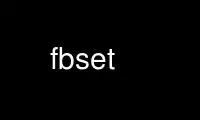
This is the command fbset that can be run in the OnWorks free hosting provider using one of our multiple free online workstations such as Ubuntu Online, Fedora Online, Windows online emulator or MAC OS online emulator
PROGRAM:
NAME
fbset - show and modify frame buffer device settings
SYNOPSIS
fbset [options] [mode]
DESCRIPTION
fbset is a system utility to show or change the settings of the frame buffer device. The
frame buffer device provides a simple and unique interface to access different kinds of
graphic displays.
Frame buffer devices are accessed via special device nodes located in the /dev directory.
The naming scheme for these nodes is always fb<n>, where n is the number of the used frame
buffer device.
fbset uses an own video mode database located in /etc/fb.modes. An unlimited number of
video modes can be defined in this database. For further information see fb.modes(5).
OPTIONS
If no option is given, fbset will display the current frame buffer settings.
General options:
--help, -h
display an usage information
--test don't change, just test whether the mode is valid
--show, -s
display the video mode settings. This is default if no further option or
only a frame buffer device via -fb is given
--info, -i
display all available frame buffer information
--verbose, -v
display information what fbset is currently doing
--version, -V
display the version information about fbset
--xfree86, -x
display the timing information as it's needed by XFree86
Frame buffer device nodes:
--all, -a
change all virtual consoles on this device
-fb <device>
device gives the frame buffer device node. If no device via -fb is given,
/dev/fb0 is used
Video mode database:
-db <file>
set an alternative video mode database file (default is /etc/fb.modes), see
also fb.modes(5)
Display bitfield colors:
-rgba <red,green,blue,alpha>
each in length or length/offset color format
Display geometry:
-xres <value>
set visible horizontal resolution (in pixels)
-yres <value>
set visible vertical resolution (in pixels)
-vxres <value>
set virtual horizontal resolution (in pixels)
-vyres <value>
set virtual vertical resolution (in pixels)
-depth <value>
set display depth (in bits per pixel)
-nonstd <value>
select nonstandard video mode
--geometry, -g ...
set all geometry parameters at once in the order <xres> <yres> <vxres>
<vyres> <depth>, e.g. -g 640 400 640 400 4
-match
make the physical resolution match the virtual resolution
Display timings:
-pixclock <value>
set the length of one pixel (in picoseconds). Note that the frame buffer
device may only support some pixel lengths
-left <value>
set left margin (in pixels)
-right <value>
set right margin (in pixels)
-upper <value>
set upper margin (in pixel lines)
-lower <value>
set lower margin (in pixel lines)
-hslen <value>
set horizontal sync length (in pixels)
-vslen <value>
set vertical sync length (in pixel lines)
--timings, -t ...
set all timing parameters at once in the order <pixclock> <left> <right>
<upper> <lower> <hslen> <vslen>, e.g. -t 35242 64 96 35 12 112 2
Display flags:
-accel {false|true}
set hardware text acceleration enable
-hsync {low|high}
set the horizontal sync polarity
-vsync {low|high}
set the vertical sync polarity
-csync {low|high}
set the composite sync polarity
-gsync {false|true}
set synch on green
-extsync {false|true}
enable or disable external resync. If enabled the sync timings are not
generated by the frame buffer device and must be provided externally
instead. Note that this option may not be supported by every frame buffer
device
-sync <value>
set custom sync flags. If specified, this value is bitwise or-ed to the
other sync flags. This is useful for drivers that use custom sync flags
-bcast {false|true}
enable or disable broadcast modes. If enabled the frame buffer generates the
exact timings for several broadcast modes (e.g. PAL or NTSC). Note that this
option may not be supported by every frame buffer device
-laced {false|true}
enable or disable interlace. If enabled the display will be split in two
frames, each frame contains only even and odd lines respectively. These two
frames will be displayed alternating, this way twice the lines can be
displayed and the vertical frequency for the monitor stays the same, but the
visible vertical frequency gets halved
-double {false|true}
enable or disable doublescan. If enabled every line will be displayed twice
and this way the horizontal frequency can easily be doubled, so that the
same resolution can be displayed on different monitors, even if the
horizontal frequency specification differs. Note that this option may not be
supported by every frame buffer device
Display positioning:
-move {left|right|up|down}
move the visible part of the display in the specified direction
-step <value>
set step size for display positioning (in pixels or pixel lines), if -step
is not given display will be moved 8 pixels horizontally or 2 pixel lines
vertically
EXAMPLE
To set the used video mode for X insert the following in rc.local:
fbset -fb /dev/fb0 640x480-60
and make the used frame buffer device known to X:
export FRAMEBUFFER=/dev/fb0
Use fbset online using onworks.net services
